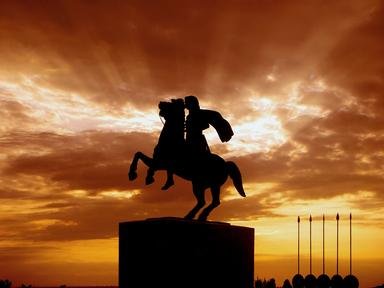Quiz Answer Key and Fun Facts
1. Alexander ferried his army across this body of water to Asia Minor in 334 BC. Name this body of water.
2. At the outset of Alexander's invasion of Asia Minor, how many ships did he and Darius have each respectively?
3. After the Battle of the River Granicus in 334 BC, Alexander pursued the remains of the defeated Persian army east into the interior parts of Asia Minor.
4. What were Alexander's main concerns about the Persian navy?
5. After Granicus, Alexander besieged this port city first on the Asia Minor coast.
6. Alexander then moved further south into Caria and besieged Halicarnassus, which was defended by a Greek mercenary general. Name the general.
7. In summer of 333 BC, Memnon began to execute his own naval strategy of attacking Alexander's supply chokepoint at the Hellespont. What was the outcome of his efforts?
8. After subduing the interior of Asia Minor and then its southern coast, and fighting and winning the Battle of Issus in November 333 BC, Alexander turned south, again ignoring the defeated Persian army, into Syria along the Phoenician coast. Byblos, Arwad and Sidon surrendered to him. But Tyre refused. Why?
9. In July 332 BC, after a difficult seven month siege, the Macedonians finally conquered Tyre. What was the turning point?
10. A biographer quoted Alexander as follows on his novel naval strategy:
"Friends and allies, I see that an exhibition will not be safe for us, so long as the Persians retain sovereignty over the sea; nor is it a safe course, both for other reasons,and especially looking at matters in Greece, or us to pursue Darius, leaving in our rear the city of Tyre itself in doubtful allegiance, and Egypt and Cyprus in the occupation of the Persians. I am apprehensive lest we advance with our forces towards Babylon and in pursuit of Darius, the Persians should again forsooth conquer the maritime districts, and transfer the war into Greece with a larger army...But if the whole of Phoenicia would be in our possession, and the fleet of Phoenicia,which is the most numerous and the best in the Persian navy, would in all probability come over to us...then also Cyprus coming over to us...[then] Egypt will be an easy matter for us....[And there shall] be no anxiety about Greece and our on home...and we shall be able to undertake the expedition to Babylon with safety in regard to affairs at home."
Who was the biographer?
Source: Author
Craterus
This quiz was reviewed by FunTrivia editor
bloomsby before going online.
Any errors found in FunTrivia content are routinely corrected through our feedback system.
